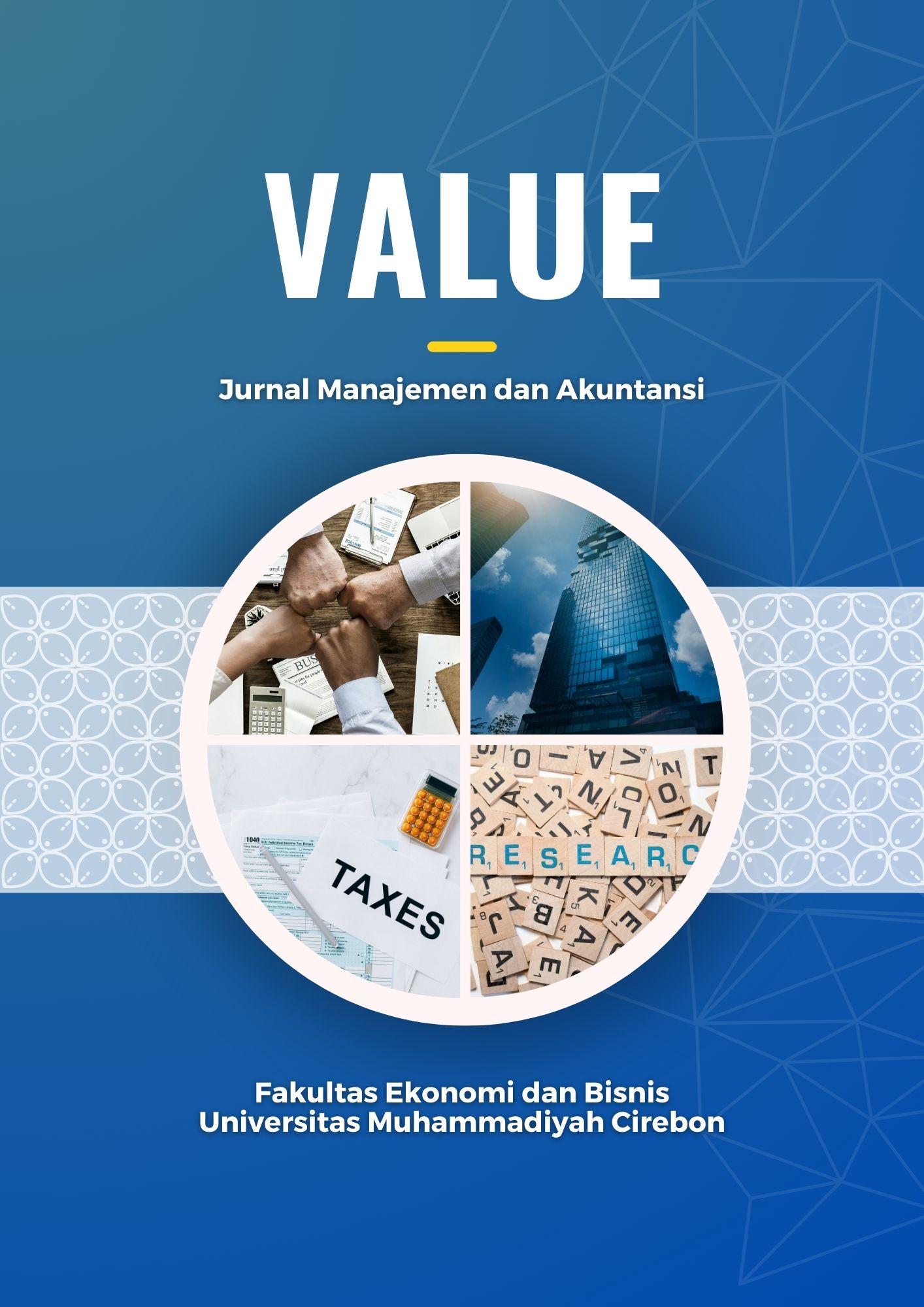Pengaruh Customer Trust Terhadap Customer Engagement Dan Swift Guanxi Dalam Live Streaming
DOI:
https://doi.org/10.32534/jv.v20i1.6631Keywords:
Customer Trust, Customet Engagement, Swift Guanxi, Live Streaming CommerceAbstract
The increasing use of the internet has become a major driver of business transformation in the field of e-commerce. This phenomenon is relevant because live streaming interactions can build strong relationships between sellers and buyers, which can increase engagement and customer trust. The main challenges in e-commerce, including live streaming commerce, are maintaining product quality and avoiding fraud, which often results in decreased customer trust. This study aims to examine the effect of customer trust on customer engagement in the context of live streaming commerce, with swift guanxi as a mediating variable. The method used is Partial Least Square Structural Equation Modeling (PLS-SEM) with data from 333 Generation Z respondents who actively shop via live streaming. The results of the study show that Trust in Broadcasters and Trust in Community Members have a significant positive effect on Customer Engagement, while Trust in Products does not show a significant effect.
References
Algharabat, R. et al. (2020) ‘Investigating the antecedents of customer brand engagement and consumer-based brand equity in social media’, Journal of Retailing and Consumer Services, 53(January), p. 101767. Available at: https://doi.org/10.1016/j.jretconser.2019.01.016.
Annur, (2024) 'Ada 185 Juta Pengguna Internet di Indonesia pada Januari 2024', teknoligi dan telekomunikasi. Retrieved from https://databoks.katadata.co.id/teknologi-telekomunikasi/statistik/de7b25bfae5971c/ada-185-juta-pengguna-internet-di-indonesia-pada-januari-2024
Aristyana Dewi, M.A. et al. (2017) ‘Trust transfer and its effects on the continuance usage of mobile service in B2C E-marketplaces’, Proceedings ot the 21st Pacific Asia Conference on Information Systems: ‘“Societal Transformation Through IS/IT”’, PACIS 2017 [Preprint], (September). Retrieved from https://www.researchgate.net/profile/Achmad-Hidayanto-2/publication/320015071_Trust_Transfer_and_Its_Effects_on_The_Continuance_Usage_of_Mobile_Service_in_B2C_E-marketplaces/links/59c8abeda6fdccc7192720db/Trust-Transfer-and-Its-Effects-on-The-Continuance-Usage-of-Mobile-Service-in-B2C-E-marketplaces.pdf
Bandura, A. (1986). Social foundations of thought and action. Englewood Cliffs, NJ, 1986(23-28), 2. Brodie et al., 2011. https://doi.org/10.4135/9781446221129.n6
Bugshan, H. and Attar, R.W. (2020) ‘Social commerce information sharing and their impact on consumers’, Technological Forecasting and Social Change, 153(December 2019), p. 119875. Available at: https://doi.org/10.1016/j.techfore.2019.119875.
Buttle, F. A. (1998). Word of mouth: understanding and managing referral marketing. Journal of strategic marketing, 6(3), 241-254. http://dx.doi.org/10.1080/096525498346658
Cai, J. and Wohn, D.Y. (2019) ‘Live streaming commerce: Uses and gratifications approach to understanding Consumers’ motivations’, Proceedings of the Annual Hawaii International Conference on System Sciences, 2019-January(February), pp. 2548–2557. Available at: https://doi.org/10.24251/hicss.2019.307.
Carlson, J. et al. (2019) ‘Feel the VIBE: Examining value-in-the-brand-page-experience and its impact on satisfaction and customer engagement behaviours in mobile social media’, Journal of Retailing and Consumer Services, 46(April), pp. 149–162. Available at: https://doi.org/10.1016/j.jretconser.2017.10.002.
Casal dkk. 2020
Chen, Y. and Wang, L. (2019) ‘Commentary: Marketing and the Sharing Economy: Digital Economy and Emerging Market Challenges’, Journal of Marketing, 83(5), pp. 28–31. Available at: https://doi.org/10.1177/0022242919868470.
Chiu, T.S. et al. (2018) ‘The contradiction of trust and uncertainty from the viewpoint of swift guanxi’, Internet Research, 28(3), pp. 716–745. Available at: https://doi.org/10.1108/IntR-06-2017-0233.
Chu & Kim (2011). Determinants of consumer engagement in electronic word-of-mouth (eWOM) in social networking sites. January 2011International Journal of Advertising. 30 (1). https://doi.org/10.2501/IJA-30-1-047-075
Mara, D. D., Edwards, P., Clark, D., & Mills, S. W. (1993). A rational approach to the design of wastewater-fed fishponds. Water Research, 27(12), 1797-1799. http://dx.doi.org/10.1016/0043-1354(93)90120-7
Dholakia, U.M., Bagozzi, R.P. and Pearo, L.K. (2004) ‘A social influence model of consumer participation in network- and small-group-based virtual communities’, International Journal of Research in Marketing, 21(3), pp. 241–263. Available at: https://doi.org/10.1016/j.ijresmar.2003.12.004.
Dong, X. and Wang, T. (2018) ‘Social tie formation in Chinese online social commerce: The role of IT affordances’, International Journal of Information Management, 42(April 2017), pp. 49–64. Available at: https://doi.org/10.1016/j.ijinfomgt.2018.06.002.
Effendi, S. et al. (2020) ‘Pengaruh Promosi Penjualan, Electronic Word of Mouth dan Hedonic Shopping Motivation Terhadap Pembelian Impulsif pada Aplikasi Shopee’, Jurnal Akuntansi dan Manajemen, 17(02), pp. 22–31. Available at: https://doi.org/10.36406/jam.v17i02.332.
Fan, J. et al. (2019) ‘Impact of social support and presence on swift guanxi and trust in social commerce’, Industrial Management and Data Systems, 119(9), pp. 2033–2054. Available at: https://doi.org/10.1108/IMDS-05-2019-0293.
Finn, A. (2005) ‘Reassessing the foundations of customer delight’, Journal of Service Research, 8(2), pp. 103–116. Available at: https://doi.org/10.1177/1094670505279340.
Guo, L. et al. (2021) ‘Effects of customer trust on engagement in live streaming commerce: mediating role of swift guanxi’, Internet Research, 31(5), pp. 1718–1744. Available at: https://doi.org/10.1108/INTR-02-2020-0078.
Goyal et al., 2022
Hair et al. (2010) ' Multivariate data analysis'. Retrieved from https://openlibrary.org/books/OL22691711M/Multivariate_data_analysis
He et al. (2017)
Hsu, C.L. and Liao, Y.C. (2014) ‘Exploring the linkages between perceived information accessibility and microblog stickiness: The moderating role of a sense of community’, Information and Management, 51(7), pp. 833–844. Available at: https://doi.org/10.1016/j.im.2014.08.005.
Hu, M. and Chaudhry, S.S. (2020) ‘Enhancing consumer engagement in e-commerce live streaming via relational bonds’, Internet Research, 30(3), pp. 1019–1041. Available at: https://doi.org/10.1108/INTR-03-2019-0082.
Jessica, M. and Rusliyawati, R. (2023) ‘Rahasia Guanxi Dalam Praktik Akuntansi Dan Bisnis Etnis Tionghoa’, Jurnal Akuntansi Multiparadigma, 14(2), pp. 219–235. Available at: https://doi.org/10.21776/ub.jamal.2023.14.2.16.
Jung, N.Y., Kim, Soohyun and Kim, Soyoung (2014) ‘Influence of consumer attitude toward online brand community on revisit intention and brand trust’, Journal of Retailing and Consumer Services, 21(4), pp. 581–589. Available at: https://doi.org/10.1016/j.jretconser.2014.04.002.
Kim et al. (2018)
Kellerman, H. (1983) ‘an Epigenetic Theory of Emotions in Early Development’, Emotions in Early Development, 16(December), pp. 315–349. Available at: https://doi.org/10.1016/b978-0-12-558702-0.50017-0.
Komiak, S.X. and Benbasat, I. (2003) ‘Understanding Customer Trust in Agent-Mediated Electronic Commerce, Web-Mediated Electronic Commerce, and Traditional Commerce’, Information Technology and Management, 5(1/2), pp. 181–207. Available at: https://doi.org/10.1023/b:item.0000008081.55563.d4.
Leal, G.P.A., Hor-Meyll, L.F. and de Paula PessÔa, L.A.G. (2014) ‘Influence of virtual communities in purchasing decisions: The participants’ perspective’, Journal of Business Research, 67(5), pp. 882–890. Available at: https://doi.org/10.1016/j.jbusres.2013.07.007.
Lee, 2005
Li et al., 2018 ' Respond', 108(10), p. e2. https://doi.org/10.2105/ajph.2018.304672
Liang et al. (2018) ' Exploring the relationship between satisfaction, trust and switching intention, repurchase intention in the context of Airbnb', International Journal Of Hospitality Management, 69, 41-48. http://dx.doi.org/10.1016/j.ijhm.2017.10.015
Lin et al., 2017 ' The roles of learning strategies and motivation in online language learning: A structural equation modeling analysis', Computers & Education, 113(1), 75-85. http://dx.doi.org/10.1016/j.compedu.2017.05.014
Lin, J. et al. (2018) ‘Understanding Chinese consumer engagement in social commerce: The roles of social support and swift guanxi’, Internet Research, 28(1), pp. 2–22. Available at: https://doi.org/10.1108/IntR-11-2016-0349.
Lin, J. et al. (2019) ‘Understanding the interplay of social commerce affordances and swift guanxi: An empirical study’, Information and Management, 56(2), pp. 213–224. Available at: https://doi.org/10.1016/j.im.2018.05.009.
Lin, Q. and Nuangjamnong, C. (2022) ‘Exploring the Role of Influencers and Customer Engagement on Purchase Intention in TikTok Live streaming Shopping’, International Journal of Social Sciences and Humanities Invention, 9(12), pp. 7469–7498. Available at: https://doi.org/10.18535/ijsshi/v9i012.04.
Lisha, C. et al. (2017) ‘Integrating guanxi into technology acceptance: An empirical investigation of WeChat’, Telematics and Informatics, 34(7), pp. 1125–1142. Available at: https://doi.org/10.1016/j.tele.2017.05.003.
Liu, L. et al. (2018) ‘Trust transfer in social media brand communities: The role of consumer engagement’, International Journal of Information Management, 41(28), pp. 1–13. Available at: https://doi.org/10.1016/j.ijinfomgt.2018.02.006.
Lu, Y., Zhao, L. and Wang, B. (2010) ‘From virtual community members to C2C e-commerce buyers: Trust in virtual communities and its effect on consumers’ purchase intention’, Electronic Commerce Research and Applications, 9(4), pp. 346–360. Available at: https://doi.org/10.1016/j.elerap.2009.07.003.
Mao, J., Price, D. D., & Mayer, D. J. (1995). Mechanisms of hyperalgesian and morphine tolerance: a current view of their possible interactions. Pain, 62(3), 259-274.
McKnight, D.H., Choudhury, V. and Kacmar, C. (2002) ‘Developing and validating trust measures for e-commerce: An integrative typology’, Information Systems Research, 13(3), pp. 334–359. Available at: https://doi.org/10.1287/isre.13.3.334.81.
Melorose, J., Perroy, R. and Careas, S. (2015) ‘TRUST AND TAM IN ONLINE SHOPPING: AN INTEGRATED MODEL1 By’:, Statewide Agricultural Land Use Baseline 2015, 1(1), pp. 51–90.
Molinillo, S., Anaya-Sánchez, R. and Liébana-Cabanillas, F. (2020) ‘Analyzing the effect of social support and community factors on customer engagement and its impact on loyalty behaviors toward social commerce websites’, Computers in Human Behavior, 108(June 2017), p. 105980. Available at: https://doi.org/10.1016/j.chb.2019.04.004.
Morgan, R. M. (1994). The commitment-trust theory of relationship marketing. Journal of Marketing, 58(3), 20–38. https://doi.org/10.1177/002224299405800302
Ou, C.X., Pavlou, P.A. and Davison, R.M. (2014) ‘Swift guanxi in online marketplaces: The role of computer-mediated communication technologies’, MIS Quarterly: Management Information Systems, 38(1), pp. 209–230. Available at: https://doi.org/10.25300/MISQ/2014/38.1.10.
Park, H.J. and Lin, L.M. (2020) ‘The effects of match-ups on the consumer attitudes toward internet celebrities and their live streaming contents in the context of product endorsement’, Journal of Retailing and Consumer Services, 52(November 2018), p. 101934. Available at: https://doi.org/10.1016/j.jretconser.2019.101934.
Putnam, R. D. (2000). Bowling alone: America’s declining social capital: Originally published in Journal of Democracy 6 (1), 1995. Culture and Politics: A Reader, 223-234. https://link.springer.com/chapter/10.1007/978-1-349-62965-7_12
Sekaran & Bougie. (2010)
Seraj, M. (2012) ‘We Create, We Connect, We Respect, Therefore We Are: Intellectual, Social, and Cultural Value in Online Communities’, Journal of Interactive Marketing, 26(4), pp. 209–222. Available at: https://doi.org/10.1016/j.intmar.2012.03.002.
Shi, S. et al. (2018) ‘ The impact of perceived online service quality on swift guanxi ’, Internet Research, 28(2), pp. 432–455. Available at: https://doi.org/10.1108/intr-12-2016-0389.
Signal Theory, Spence, 1973
Stewart, K.J. (2003) ‘Trust transfer on the World Wide Web’, Organization Science, 14(1), pp. 5–17. Available at: https://doi.org/10.1287/orsc.14.1.5.12810.
Sun, Y. et al. (2016) ‘Does social climate matter? on friendship groups in social commerce’, Electronic Commerce Research and Applications, 18, pp. 37–47. Available at: https://doi.org/10.1016/j.elerap.2016.06.002.
Sun, Y. et al. (2019) ‘How live streaming influences purchase intentions in social commerce: An IT affordance perspective’, Electronic Commerce Research and Applications, 37(August), p. 100886. Available at: https://doi.org/10.1016/j.elerap.2019.100886
Turner, A., & Filella, M. (2021). Hazardous metal additives in plastics and their environmental impacts. Environment International, 156, 106622. https://www.sciencedirect.com/science/article/pii/S0160412021002476
Van Doorn, J. et al. (2010) ‘Customer engagement behavior: Theoretical foundations and research directions’, Journal of Service Research, 13(3), pp. 253–266. Available at: https://doi.org/10.1177/1094670510375599.
Wongkitrungrueng, A. and Assarut, N. (2020) ‘The role of live streaming in building consumer trust and engagement with social commerce sellers’, Journal of Business Research, 117(November 2017), pp. 543–556. Available at: https://doi.org/10.1016/j.jbusres.2018.08.032.
Zhang, M. et al. (2020) ‘E-service quality on live streaming platforms: swift guanxi perspective’, Journal of Services Marketing, 35(3), pp. 312–324. Available at: https://doi.org/10.1108/JSM-01-2020-0009.
Zhao, J. Di, Huang, J.S. and Su, S. (2019) ‘The effects of trust on consumers’ continuous purchase intentions in C2C social commerce: A trust transfer perspective’, Journal of Retailing and Consumer Services, 50(January), pp. 42–49. Available at: https://doi.org/10.1016/j.jretconser.2019.04.014.
Zhou and Li, 2014
Zhou et al., 2019) ‘The magic of danmaku: A social interaction perspective of gift sending on live streaming platforms’, Electronic Commerce Research and Applications, 34. Available at: https://doi.org/10.1016/j.elerap.2018.11.002.


















